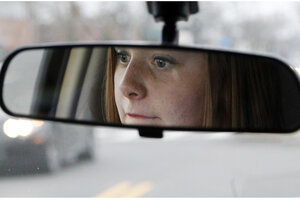Teen driver in the house? For cheaper insurance, avoid these states.
Adding a teen driver to an auto insurance policy can raise premiums by 80 percent, according to a new study. Which state has the biggest premium hikes for insuring teenage drivers, and what can parents do to save money?

Student driver Kaitlin Kearns takes a driving lesson from D&D Driving School instructor Bob White on Jan. 24, 2012. Adding a teen driver to an auto insurance policy can raise premiums by 80 percent, according to a new study.
Chris Stewart/Dayton Daily News/AP/File
Having a newly-licensed teenage driver in the house comes with many emotions, including worry over his or her safety and relief from having one more person around to run errands or cart a younger sibling to soccer practice. But you should be prepared for yet another feeling: sticker shock. That's because your insurance premiums will nearly double for insuring your teen driver.
American families who add a young driver to their car insurance will see their annual premiums increase 80 percent on average, according to a Quadrant Information Services study commissioned by insuranceQuotes.com. But for some states, the actual spike is much higher.
In New Hampshire, parents can expect a 114.92 percent average increase on their insurance premiums when they add their teen drivers to their existing policies. Wyoming, Illinois, Maine, and Rhode Island are the other states that at least double premium rates.
This is the third year insuranceQuotes.com has conducted the study, says senior insurance analyst Laura Adams, yet the numbers still surprise her.
“It still shocks me that paying 80 percent more is the average,” she says in a phone interview.
Families in Hawaii see the lowest markup on their auto insurance after adding teen drivers; on average, premiums increase 16.83 percent. But, the Aloha State is the outlier in this case. Drivers in New York, the state with the second-lowest increase, will see a 53 percent increase on insurance premiums if they add teenagers to their existing policies.
The study also found a huge cost divide by gender. No "pink tax" here: Insuring a male teen will cause a married couple’s premiums to jump by 92 percent on average. Meanwhile, adding a female teenager to a family’s auto insurance drives up premiums by 67 percent.
Why is there such a wide range in costs? Adams says most states charge extra for insuring drivers based a variety of factors, including a lack of driving experience, if a person is driving an older car, or if the driver is frequently on the roads. Location and weather are also major factors in calculating insurance premiums, she added. People in urban areas, where there is a higher volume of drivers, tend to pay more than people living in rural areas.
However, every state has its own laws and regulations for insuring teen drivers, Adams says. Hawaii is the only state that bans insurance providers to consider age, gender or length of driving experience when determining premiums. Massachusetts, Michigan, Montana, North Carolina, and Pennsylvania also prohibit insurance companies from determining rates based on gender.
That said, the upticks in insurance costs is not unprecedented. The number teens involved in car crashes and fatalities is disproportionately high to the number of teen drivers, according to Insurance Institute for Highway Safety. Risk for fatal crashes is highest for Americans ages 16-17. In 2013, two out of every three American teenagers killed in a car crash were males.
But there are signs of progress: the number of teen deaths from car crashes in 2013 has gone down by 11 percent since 2012 and by 71 percent since 1975. The other good news is that most drivers' insurance rates drop at age 25, and continue to decline until age 70, according to insurance provider Esurance. However, if a driver has a checkered driving history with numerous tickets and accidents, then insurance rates are more likely to stay high.
"I encourage parents to do everything they can," when it comes to reducing their insurance costs, Adams says. One possibility: Many auto insurance providers offer "good student discounts." Families with young drivers that are in high school, college, or even graduate school, and have at least a B average are eligible for reduced rates. But parents need to remember to submit proof of their child’s academic achievement, such as a report card or a transcript, to receive the discount.
Adams’ other suggestions include shopping around to ensure that families are getting the best deals on car insurance, and enrolling your teen driver in a course on driver safety. Some insurance companies offer discounts if a teen takes a safety class, Adams says, but families will need to go to their state’s Department of Motor Vehicles website to find a list of approved courses.

